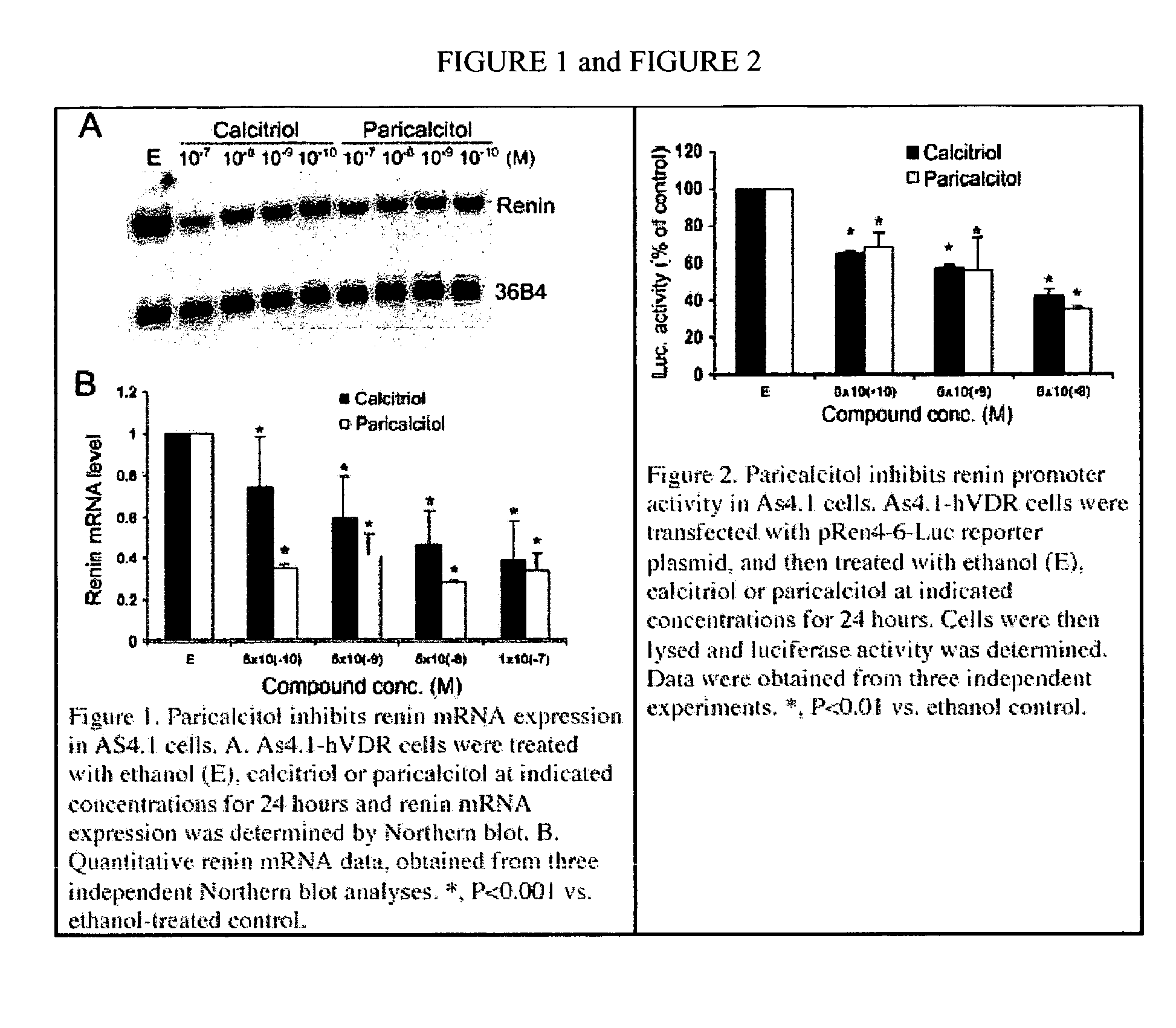Use of vitamin Ds to down regulate the renin-angiotensin-aldosterone system
a technology of angiotensin and aldosterone, which is applied in the field of vitamin d, can solve the problems of no commercially available renin inhibitors to treat over-activation of raas, ace escape and increase angiotensin ii and aldosterone production, and achieve the effects of preventing ace/aldosterone escape, treating and delaying the progression of diseases, and preventing the escape of ace/aldo
- Summary
- Abstract
- Description
- Claims
- Application Information
AI Technical Summary
Benefits of technology
Problems solved by technology
Method used
Image
Examples
example i
Activity of Paricalcitol to Suppress Renin Expression
[0027] Using an in vitro system, an examination was carried out in order to determine the ability of paricalcitol to suppress renin expression. As shown in FIG. 1, based upon Northern blot analysis, paricalcitol treatment of As4.1-hVDR cells dose-dependently inhibits renin mRNA expression. In fact, its renin-inhibiting activity appears a bit more potent than calcitriol (FIG. 1A and B). This inhibitory activity is confirmed by renin promoter-luciferase assays, which examine the activity of paricalcitol to suppress renin gene transcription. In these assays, paricalcitol appears as least as potent as calcitriol in suppressing the activity of the renin gene promotor (FIG. 2).
example ii
VDR Expression Profiles in Human, Normal Tissues
[0028] Due to the fact that (1) the leading cause of death for CKD patients is cardiovascular complications, (2) VDR activators (VDRAs) provide survival benefit for CKD patients, and (3) the effect is more profound for paricalcitol over calcitriol, it was hypothesized that VDRAs may affect the cardiovascular system. Since adult human cardiomyocytes do not express VDR (Q-PCR data shown in FIG. 3), likely the cardiovascular protective effects of VDRAs are on the functionality of smooth muscle cells and / or endothelial cells.
[0029] Relative expression was determined by quantitative PCR for Vitamin D receptor in various normal human tissues. The VDR expression level in each tissue was normalized to the VDR level in the reference pooled RNA sample.
example iii
Effect of VDR Activators on PAI-1 Expression in Human Coronary Artery Smooth Muscle Cells
[0030] The effect of paricalcitol and calcitriol on PAI-1 in primary culture of human coronary artery smooth muscle cells was investigated. (See FIG. 4.) PAI-1 (plasminogen activator inhibitor type-1) is one of the risk markers for coronary heart disease, and is enhanced in atherosclerotic plague and co-localized with macrophages.
[0031] Human coronary artery smooth muscle cells were incubated with paricalcitol or calcitriol at the indicated concentration for 24 hr at 37° C. Samples were solubilized in SDS-PAGE sample buffer, and the protein content in each sample was determined by the Bio-Rad dye-binding protein assay. Samples were resolved by SDS-PAGE using a 4-12% gel, and proteins were electrophoretically transferred to PVDF membrane for Western blotting. The membrane was blotted for 1 h at 25° C. with 5% nonfat dry milk in PBS-T and then incubated with a mouse anti-PAI-1 monoclonal antibod...
PUM
 Login to View More
Login to View More Abstract
Description
Claims
Application Information
 Login to View More
Login to View More - R&D
- Intellectual Property
- Life Sciences
- Materials
- Tech Scout
- Unparalleled Data Quality
- Higher Quality Content
- 60% Fewer Hallucinations
Browse by: Latest US Patents, China's latest patents, Technical Efficacy Thesaurus, Application Domain, Technology Topic, Popular Technical Reports.
© 2025 PatSnap. All rights reserved.Legal|Privacy policy|Modern Slavery Act Transparency Statement|Sitemap|About US| Contact US: help@patsnap.com



